You are using an out of date browser. It may not display this or other websites correctly.
You should upgrade or use an alternative browser.
You should upgrade or use an alternative browser.
What Alloy should I make
- Thread starter PAT303
- Start date
Ian
Notorious member
I learned the lesson of not blending everything ya have into one alloy many years ago. When things change and they will, a new caliber or whatever and you want to blend a new alloy or just use some of that soft that you "had" you can't, everything went into the one alloy and that's what ya got. Experimenting is great but all your eggs in one basket isn't.
Good point in general. I maintain that in this case he's good to go blending it all. As was mentioned it can be sweetened or heat treated as-is, and if that isn't good enough, the new project may be oersnickety enough to require store-bought alloy anyway.
Thanks everyone, I was going to smelt it all down into manageable ingots and then add them all together in equal parts, as many have said I'd like to have one large amount of equal alloy to remove that variable, I have 5kgs of tin I can add but the alloy should be tin rich to start with, I can also heat treat. Thanks everyone for the advise, really appreciated and I will get into smelting it into ingots and let you know what the BHN is.
I shoot the largest diameter bullets that will chamber, generally I take 5 fired unsized cases and measure the inside diameter and go up or down from there.Any tin or pewter? Some fellows may want to know that.
Have you checked bore size, pound casted or measured any of your throats in any way?
I am going to refrain from an answer, because there are a lot of variables here to consider. And I am fairly green. I could probably lead you to the right path but the more experienced fellows can get you when you want to go quicker.
Also what powder(s) do you have? Alloys act differently with different powders.
There are a lot of fellows here that have been thru the mill With 30 ish calibers, over 1800 fps. Way more then me.
Ok I said I would not give an answer, but, my two cents. Mix it all together and add 4 kg of pewter, or tin. Or 8 kg of 50/50 solder.
That will put it some where in the workable zone. Then figure out how to make it work for your rifles.
Having 155 kg of one consistent alloy, will get you a pretty far.
Mitty38
Well-Known Member
I have estimated chamber size by measuring fired cases and measured barrel size by pushing a slug thru. It worked well for most stuff.I shoot the largest diameter bullets that will chamber, generally I take 5 fired unsized cases and measure the inside diameter and go up or down from there.
Till..... I was wanting to try making a bore rider work in a cheap savage axis 06. Actually, my first from casting to shooting tapper wall rifle round, attempt.
These fellows know a lot more than me. Ended up following their tutorial thread on pound casting, got some good measurements. Wish I could find the thread.
Then they walked me thru figuring out the dimensions for the neck and the nose. I was able to powder coat an under sized Bore rider, then size to spec. In an alloy that was basically COWW with a little tin(about 12 BHN). Worked out really well for me. There is a whole thread or two on it here.
Last edited:
Mitty38
Well-Known Member
CWLONGSHOT
Well-Known Member
For you, I would omit the sheet lead and most all of that tin. Then Mix the remainder into one alloy.I'm in a similar boat. I have 400lbs of unprocessed indoor range lead. About 150lbs of CWW, 75 lbs of Lino, 75 lbs of pure sheet lead, a couple dozen lbs of pewter and smaller batches of other random hardish lead alloys.
My plan is to mix as much of it as I can together so I can have a large batch (for my purposes, possibly a lifetime batch) of 2.5%Sb, 1.5%Sn, 96Pb. A large consistent batch will allow me to make or shoot anything in the future. I probably won't have to tweak anything unless I get into some nerdy super science project.
Then when I'm all done with the very large batch, I'll send it off somewhere for testing so I know as best as possible what I am dealing with and how close I am to what I expected.
Mix that sheet lead with tin for a batch of 10:1 & 20:1. IMHO, Very handy alloys for hand guns and if you do HP bullets too.
That much tin in the "mix all together" is a waste if tin. If thats what ya really end up doing, Id sell the tin off. At least ya would recoupe $$ as its its totally wasted at that percentage if mixed together.
COWW Equivalent and 10:1 & 20:1 is my main stay. When and if I feel harder is needed Ill quench that COWW ALLOY. Then for my HP Ill use the alloy with tin. Excellent results.
I also use the 20:1 for under 1800 rifle loads where I want real expansion.
Everything is powder coated here.
CW
Last edited:
Bret4207
At the casting bench in the sky. RIP Bret.
Just remember that Bhn is only a small part of the story. Please don't get hung up on a relative number as indicating anything truly useful. It's useful in general terms and there it ends.An update, I have done a trial smelt with equal 2kg amounts of of hardball range alloy, COWW and sheet lead (flashing) and another with just 2kg of range alloy and COWW to get an idea what I have, I'll do some BHN testing after a week.
The 92/6/2 cut in half with the pure lead will still be riches overall than the COWW.
COWW will do about anything that needs doing with cast.
I would mix it all together and move forward. The alloy will do very well as cast but will also respond well to heat treating if needed.
COWW will do about anything that needs doing with cast.
I would mix it all together and move forward. The alloy will do very well as cast but will also respond well to heat treating if needed.
CWLONGSHOT
Well-Known Member
Yup thats the best part. IF ya feel the need just quench for harder bullets.
But as ya intend to Powdercoat you can almost throw out what you learned about proper hardness as it pertains to leading/fouling.
I regularly shoot 20:1 to 2000 fps with good accuracy and zero fouling
CW
But as ya intend to Powdercoat you can almost throw out what you learned about proper hardness as it pertains to leading/fouling.
I regularly shoot 20:1 to 2000 fps with good accuracy and zero fouling
CW
Ian
Notorious member
I'm just concerned that the extra lead in the melt will dilute the mix too much to the soft side, it's a waste having tin and antinomy in good qualities then soften it by adding too much lead.
When powder coating the bullets, I've found one thing critical to accuracy and function, and that is to size the bullets no larger than throat entrance diameter. Typically that puts us somewhere between nominal groove and the largest bullet the rifle will chamber with a thousandth loaded neck clearance.....usually closer to about .001" over the groove diameter depending on throat shape. Modern smokeless cartridges BTW. I have also had the best luck in .30 and .22 caliber at very high velocity and pressure using an alloy about 95-3-2 to get the extra Sb/Sn for fine (micro) grains, toughness, and malleability, but still having a little free antimony to make some long shear planes to help macro deformation on game. Too much tin is a waste, but I use more when powder coating at HV than with my normal 97-2.5-0.5 straight wheelweights/conventional lube. For over 40K psi it really helps to add some Superhard to bump the antimony up to three or a little more.
95-3-2 at 2450 fps straight into a bullet trap:
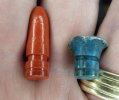
LR-308, 18" barrel:
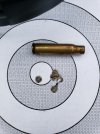
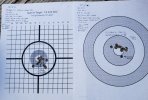
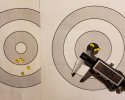
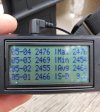
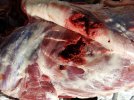
Ian
Notorious member
Same 95-3-2 alloy in the .223, powder coated, 68 grains at a shade over 2900 fps, 9" rate of twist (rifle and shooter produces about the same with premium jacketed handloads):
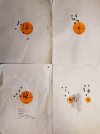
Bottom left target is water dropped and aged wheelweights plus tin for about 2.5/2.5 alloy and 18 bhn, quenched from the coating oven and aged. Small sample but didn't make much difference with that particular load, all else the same asbthe 95-3-2. Lots of ways to skin this cat, but I find a touch extra tin helps an air-cooled alloy at high speed when powder coated.

Bottom left target is water dropped and aged wheelweights plus tin for about 2.5/2.5 alloy and 18 bhn, quenched from the coating oven and aged. Small sample but didn't make much difference with that particular load, all else the same asbthe 95-3-2. Lots of ways to skin this cat, but I find a touch extra tin helps an air-cooled alloy at high speed when powder coated.
I've been thinking more and more about doing another pound cast and getting Tom to cut me a custom mold, my rifles will all do an honest 1 1/2 at 100m below 1800fps but after reading a lot on here a tapered bullet like the above type is really what I need to move forward, my bore riders are .316299 and CBE's similar copy with parallel sections or NOE .316365 which I bought to shoot longer ranges and for easy feeding. One thing about the bore riders is their square driving bands, I'm going to cut a sizer on my lathe to taper the front bands to the throat angle, little changes to improve things.
Last edited:
Ian
Notorious member
Powder coated bullets with a good tapered transition (not Saeco 315 or Loverin multi-band, mind you) tend to like a little bit of jump to self-align.
The red and blue examples of the MP 311-180 hollow point pictured above have been re-formed in a two-diameter sizing die with tapered transition between and an ejector punch bored to fit the bullet nose.
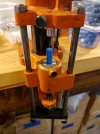
The red and blue examples of the MP 311-180 hollow point pictured above have been re-formed in a two-diameter sizing die with tapered transition between and an ejector punch bored to fit the bullet nose.

Rockydoc
Well-Known Member
Ian, it looks like that case has a crack in the shoulder/body area.
